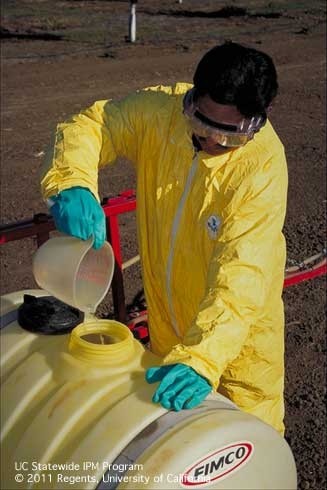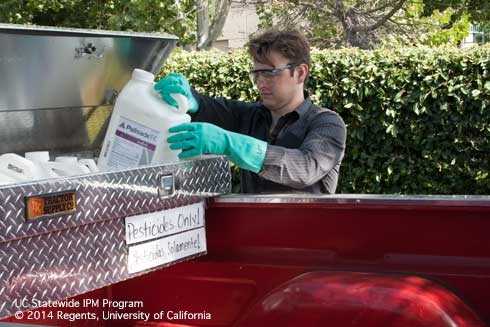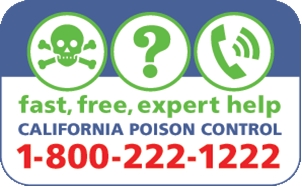When handling pesticides, always use the personal protective equipment required by the law.
Both agricultural and household pesticides can poison people if they are not properly handled. In agriculture, poisoning most often results from pesticide mixing and loading, and the most harm occurs due to spills, splashes and equipment failure. In the home, many pesticide poisoning incidents involve children swallowing pesticides, including garden products, disinfectant cleaners, or other chemicals used to control pests.
The correct way to store a pesticide during transport is in a separate, lockable storage area dedicated for pesticides only.
Labels also include important signal words such as “Danger,” “Warning,” or “Caution” that indicate how acutely toxic the chemical is to humans, as well as directions to avoid pesticide contamination of sensitive areas such as schools and hospitals. These instructions are meant to protect anyone who is at risk of being exposed to hazardous pesticide residues. It is essential to thoroughly read and understand the pesticide label before working with the pesticide, and to carefully comply with label instructions throughout the process. The UC IPM guide to Understanding Pesticide Labels for Making Proper Applications can help you do this, and is available in both English and Spanish.
Never store pesticides in food or drink containers. It is illegal!
To learn more about poisoning and how to prevent it, consider visiting the following resources:







Please clarify above claims that pesticide poisoning is a major factor in unintentional injuries. Looking at CDC data for 2015 Unintentional injuries, all ages for class 48 (accidental poisoning by pesticides) I found a total of 4. While that's 4 more than should have happened it does not make up a major portion. Also, it might be important to note that drug and alcohol related injuries make up by far the greatest portion of unintended injuries.
I appreciate your feedback. I realize now that the way the sentence is structured can read as attributing the 1073 people poisoned to CDC data. This number is from the California Pesticide Illness Surveillance Program report: http://www.cdpr.ca.gov/docs/whs/pisp/2014/2014fsummary.pdf. You will find the numbers on the fifth page (Executive Summary) of the document. We will do better to present our information sources more clearly in the future.
The CDC information you mention pertaining to fatal pesticide poisonings is correct. We wanted to discuss both fatal and nonfatal pesticide poisonings in this post to create a more comprehensive picture of the pesticide poisoning issue.
Thank you again for your comment.
If you apply pesticides anywhere outside of the home and garden, or if you work in areas where pesticides are applied, you must also comply with the annual training and certification requirements listed in CCR 6724 and 6764 (links below). Pesticide handler and fieldworker training helps prevent pesticide hazards and poisoning. This blog post cannot be used as a substitute for required training.
http://www.cdpr.ca.gov/docs/legbills/calcode/030302.htm#a6738
http://www.cdpr.ca.gov/docs/legbills/calcode/030302.htm#a6724
http://www.cdpr.ca.gov/docs/legbills/calcode/030303.htm#a6764